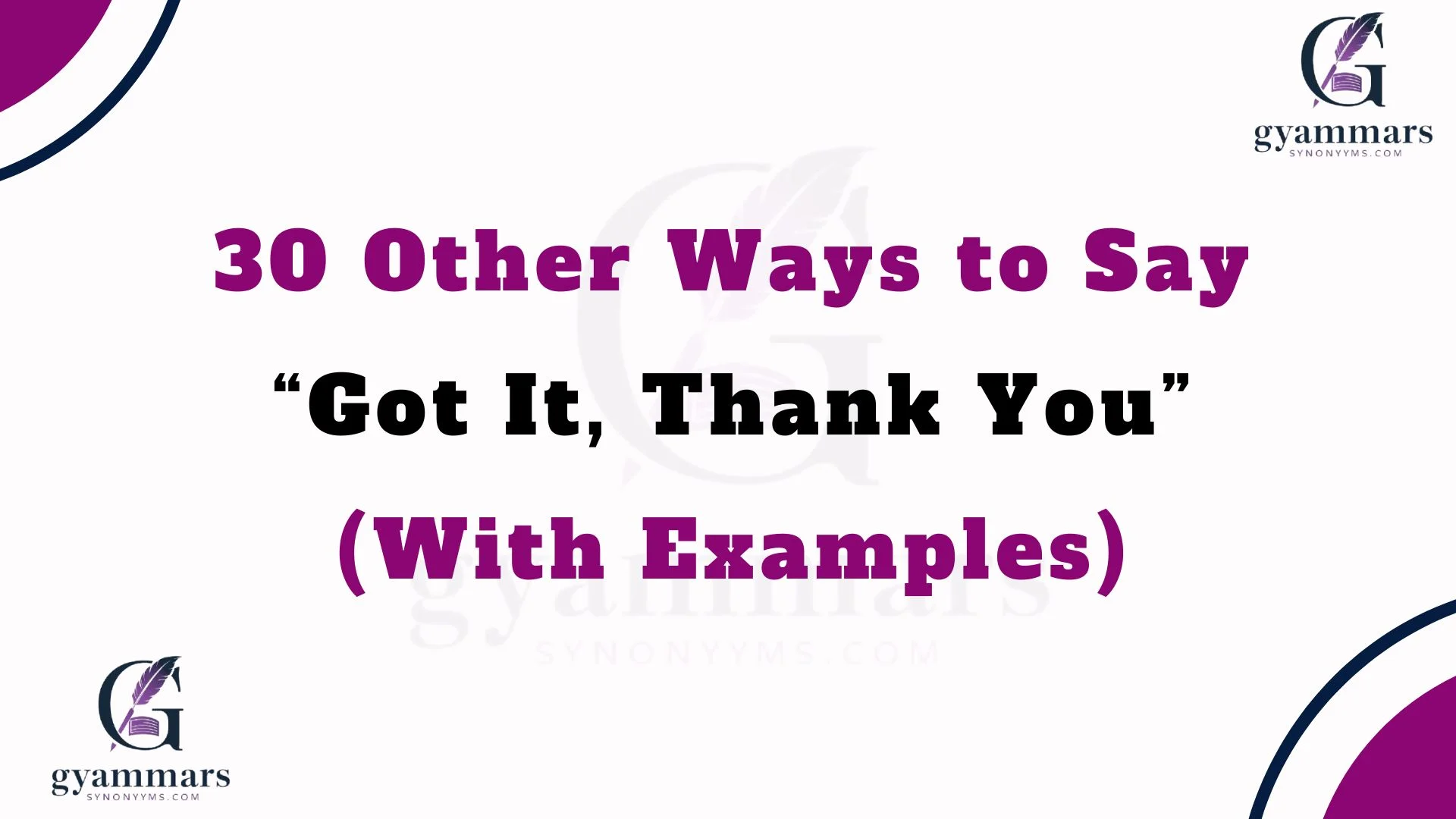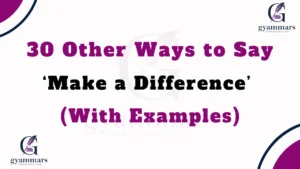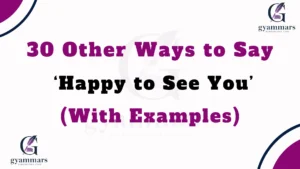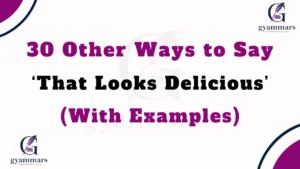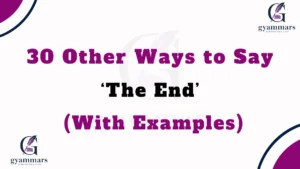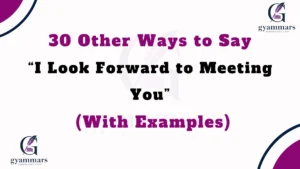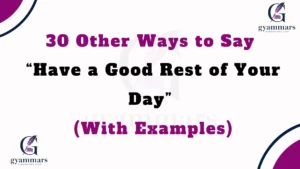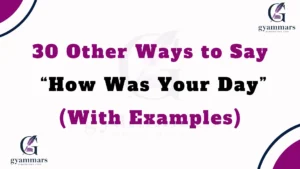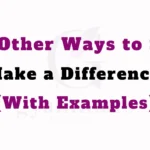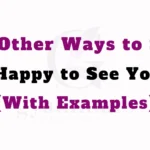Communicating effectively is more than just exchanging information—it’s about showing thoughtfulness, care, and understanding. While saying “Got it, thank you” is polite and clear, exploring other ways to express the same sentiment can make your messages feel more personal, engaging, and considerate. The following 30 alternatives are perfect for both professional and casual situations, helping you convey appreciation and acknowledgment in a way that resonates with others.
What Does “Got It, Thank You” Mean?
Definition: “Got it, thank you” is a way of acknowledging that you understand or have received information and expressing gratitude.
Detailed Explanation: It signals that the message or task is understood and appreciated. It’s a concise combination of confirmation and courtesy.
Scenario Examples:
- When a colleague sends instructions: “Got it, thank you!”
- When someone shares an update: “Got it, thank you for letting me know.”
Best Use: Ideal for emails, messages, or quick verbal acknowledgments.
Tone: Polite, professional, neutral.
Additional Notes: While clear, it can sometimes feel brief or impersonal in casual or friendly conversations.
Is It Professional/Polite to Say “Got It, Thank You”?
Yes, it’s generally professional and polite, suitable for workplace communication, customer service, or casual interactions. It balances acknowledgment and gratitude effectively without overcomplicating the message.
Pros: Quick, clear, polite. Cons: Can feel slightly formal or robotic if overused.
Pros and Cons
Pros:
- Short and clear
- Polite and respectful
- Easy to use in various contexts
Cons:
- Can feel impersonal if used repeatedly
- Lacks warmth in informal conversations
Synonyms for “Got It, Thank You”
- Understood, Thanks
- Noted, Thank You
- Thanks, I’ve Got That
- I Appreciate It
- Gotcha, Thanks
- Roger That, Thanks
- I Understand, Thank You
- Thanks for Letting Me Know
- Message Received, Thanks
- Copy That, Thank You
- Got It, Much Appreciated
- Thanks, I Understand
- Acknowledged, Thank You
- Appreciate It, Got It
- I See, Thanks
- Thank You, Noted
- Got It, Thanks a Lot
- Thanks for the Heads Up
- Got the Info, Thanks
- Thank You for Sharing
- I’ve Received It, Thanks
- Noted with Thanks
- Got It Covered, Thanks
- Received, Thank You
- Got You, Thanks
- I’m On It, Thanks
- Appreciated, Got It
- Acknowledged with Thanks
- Thanks, Got Everything
- Perfect, Thanks
1. Understood, Thanks
Definition: Acknowledging that the message is clear and showing gratitude.
Detailed Explanation: Slightly more formal than “Got it” but maintains friendliness.
Scenario Examples:
- Email from manager with instructions: “Understood, thanks!”
- Text from friend: “Understood, thanks for clarifying.”
Best Use: Workplace or casual professional messages.
Tone: Professional, polite.
Additional Notes: Works well when confirming comprehension without excessive enthusiasm.
2. Noted, Thank You
Definition: Confirms that you have taken note of the information and appreciate it.
Detailed Explanation: Often used in professional contexts to show that instructions or updates are received and logged.
Scenario Examples:
- Boss assigns a task: “Noted, thank you.”
- HR sends schedule changes: “Noted, thank you.”
Best Use: Emails, formal chats, project updates.
Tone: Formal, courteous.
Additional Notes: Slightly more formal than “Got it,” conveys attentiveness.
3. Thanks, I’ve Got That
Definition: Expresses acknowledgment and gratitude while keeping a friendly tone.
Detailed Explanation: A casual alternative suitable for friendly professional or personal conversations.
Scenario Examples:
- Friend sends directions: “Thanks, I’ve got that.”
- Team member shares a task update: “Thanks, I’ve got that.”
Best Use: Informal work chats or personal messages.
Tone: Friendly, appreciative.
Additional Notes: Adds a touch of warmth compared to “Got it, thank you.”
4. I Appreciate It
Definition: Expresses gratitude with emphasis on appreciation rather than just acknowledgment.
Detailed Explanation: Focuses more on thankfulness than on confirmation.
Scenario Examples:
- Someone shares helpful advice: “I appreciate it.”
- Manager gives constructive feedback: “I really appreciate it.”
Best Use: Personal or professional contexts where gratitude is the focus.
Tone: Warm, sincere.
Additional Notes: Slightly less about acknowledgment, more about gratitude.
5. Gotcha, Thanks
Definition: Casual acknowledgment with thanks.
Detailed Explanation: Informal, often used in conversational texting or chats.
Scenario Examples:
- Friend sends instructions: “Gotcha, thanks!”
- Colleague explains a quick task: “Gotcha, thanks.”
Best Use: Casual communication, friendly work environment.
Tone: Casual, friendly.
Additional Notes: Not suitable for formal settings.
6. Roger That, Thanks
Definition: A playful, informal acknowledgment rooted in radio/aviation lingo.
Detailed Explanation: Indicates understanding in a fun or casual tone.
Scenario Examples:
- Friend texting plans: “Roger that, thanks!”
- Gaming team chat: “Roger that, thanks.”
Best Use: Informal or humorous contexts.
Tone: Casual, playful.
Additional Notes: Best reserved for light-hearted conversations.
7. I Understand, Thank You
Definition: Clear and polite acknowledgment emphasizing understanding.
Detailed Explanation: Formal or professional; suitable for emails and meetings.
Scenario Examples:
- Manager outlines tasks: “I understand, thank you.”
- Client explains requirements: “I understand, thank you.”
Best Use: Professional communication, formal contexts.
Tone: Polite, professional.
Additional Notes: Safe in any formal scenario.
8. Thanks for Letting Me Know
Definition: Expresses gratitude for sharing information and acknowledges it.
Detailed Explanation: Friendly, emphasizes appreciation for being informed.
Scenario Examples:
- Friend shares change in plans: “Thanks for letting me know.”
- Colleague updates schedule: “Thanks for letting me know.”
Best Use: Casual or professional updates.
Tone: Friendly, polite.
Additional Notes: Adds warmth to acknowledgment.
9. Message Received, Thanks
Definition: Formal acknowledgment of a message with gratitude.
Detailed Explanation: Often used in professional communications to confirm receipt.
Scenario Examples:
- Official emails: “Message received, thanks.”
- Project instructions: “Message received, thanks.”
Best Use: Workplace emails, formal communication.
Tone: Polite, formal.
Additional Notes: Conveys attentiveness and respect.
10. Copy That, Thank You
Definition: Acknowledgment used in informal/professional settings, similar to radio communication.
Detailed Explanation: Confirms understanding while showing appreciation.
Scenario Examples:
- Team chat during work tasks: “Copy that, thank you.”
- Casual text with instructions: “Copy that, thanks.”
Best Use: Informal professional, casual texting.
Tone: Casual-professional.
Additional Notes: Slightly playful tone, works in both contexts.
11. Got It, Much Appreciated
Definition: Acknowledgment with an extra touch of gratitude.
Detailed Explanation: Shows that you not only understood but value the information.
Scenario Examples:
- Friend sends helpful advice: “Got it, much appreciated.”
- Colleague updates workflow: “Got it, much appreciated.”
Best Use: Casual and semi-formal.
Tone: Warm, appreciative.
Additional Notes: Adds depth to standard acknowledgment.
12. Thanks, I Understand
Definition: Combines gratitude and comprehension in one phrase.
Detailed Explanation: Slightly more formal than “Got it, thank you.”
Scenario Examples:
- Supervisor clarifies instructions: “Thanks, I understand.”
- Colleague explains task changes: “Thanks, I understand.”
Best Use: Professional and polite conversations.
Tone: Polite, neutral.
Additional Notes: Clear, direct, and safe for any context.
13. Acknowledged, Thank You
Definition: Formal confirmation of receipt or understanding with gratitude.
Detailed Explanation: Often used in official or professional environments.
Scenario Examples:
- Manager gives instructions: “Acknowledged, thank you.”
- Email confirmation of updates: “Acknowledged, thank you.”
Best Use: Professional, official emails or communication.
Tone: Formal, respectful.
Additional Notes: Less casual, more authoritative.
14. Appreciate It, Got It
Definition: Combines gratitude with confirmation of understanding.
Detailed Explanation: Emphasizes both acknowledgment and appreciation.
Scenario Examples:
- Friend shares instructions: “Appreciate it, got it.”
- Colleague gives task updates: “Appreciate it, got it.”
Best Use: Friendly professional or casual conversations.
Tone: Warm, friendly.
Additional Notes: Slightly more expressive than standard acknowledgment.
15. I See, Thanks
Definition: Casual acknowledgment that shows comprehension.
Detailed Explanation: Short, simple, and friendly.
Scenario Examples:
- Friend explains situation: “I see, thanks.”
- Team member shares updates: “I see, thanks.”
Best Use: Informal or casual conversations.
Tone: Friendly, neutral.
Additional Notes: Adds a conversational touch.
16. Thank You, Noted
Definition: Polite acknowledgment emphasizing that the information is recorded.
Detailed Explanation: Formal or professional acknowledgment of instructions.
Scenario Examples:
- Manager sends guidelines: “Thank you, noted.”
- Client communicates requirements: “Thank you, noted.”
Best Use: Formal or professional emails/messages.
Tone: Polite, formal.
Additional Notes: Neutral, professional phrasing.
17. Got It, Thanks a Lot
Definition: Casual acknowledgment with slightly stronger gratitude.
Detailed Explanation: Friendly way to show understanding and appreciation.
Scenario Examples:
- Friend sends detailed info: “Got it, thanks a lot.”
- Team chat update: “Got it, thanks a lot.”
Best Use: Casual contexts, friendly messages.
Tone: Warm, friendly.
Additional Notes: Adds extra warmth without being over the top.
18. Thanks for the Heads Up
Definition: Expresses acknowledgment and gratitude for a warning or advance notice.
Detailed Explanation: Friendly, often used when someone informs you about potential issues or changes.
Scenario Examples:
- Colleague warns about meeting time change: “Thanks for the heads up.”
- Friend informs about weather delay: “Thanks for the heads up.”
Best Use: Informal or professional updates.
Tone: Friendly, polite.
Additional Notes: Focuses on appreciation for forewarning.
19. Got the Info, Thanks
Definition: Acknowledges receipt of information while expressing gratitude.
Detailed Explanation: Friendly, neutral acknowledgment.
Scenario Examples:
- Team member shares stats: “Got the info, thanks.”
- Friend sends instructions: “Got the info, thanks.”
Best Use: Casual or professional messaging.
Tone: Friendly, neutral.
Additional Notes: Straightforward, clear acknowledgment.
20. Thank You for Sharing
Definition: Emphasizes gratitude for sharing information.
Detailed Explanation: Slightly more personal and thoughtful.
Scenario Examples:
- Friend shares news: “Thank you for sharing.”
- Colleague provides details: “Thank you for sharing.”
Best Use: Personal, friendly, semi-professional.
Tone: Warm, appreciative.
Additional Notes: Focused more on gratitude than just acknowledgment.
21. I’ve Received It, Thanks
Definition: Confirms receipt while expressing thanks.
Detailed Explanation: Professional and clear acknowledgment.
Scenario Examples:
- Email attachments: “I’ve received it, thanks.”
- Task instructions: “I’ve received it, thanks.”
Best Use: Professional or formal messages.
Tone: Polite, formal.
Additional Notes: Neutral, concise acknowledgment.
22. Noted with Thanks
Definition: Formal acknowledgment emphasizing both note-taking and gratitude.
Detailed Explanation: Commonly used in professional emails and messages.
Scenario Examples:
- Official instruction: “Noted with thanks.”
- Client email response: “Noted with thanks.”
Best Use: Professional contexts.
Tone: Polite, formal.
Additional Notes: Safe in almost any professional environment.
23. Got It Covered, Thanks
Definition: Shows understanding and readiness to handle a task, with gratitude.
Detailed Explanation: Combines acknowledgment with confidence in execution.
Scenario Examples:
- Task assigned by manager: “Got it covered, thanks.”
- Friend asks for help: “Got it covered, thanks.”
Best Use: Professional and casual contexts.
Tone: Confident, friendly.
Additional Notes: Adds assurance to acknowledgment.
24. Received, Thank You
Definition: Professional acknowledgment of receipt with thanks.
Detailed Explanation: Short, formal, and widely used in official communication.
Scenario Examples:
- Receiving documents: “Received, thank you.”
- Email confirmation: “Received, thank you.”
Best Use: Workplace, official emails.
Tone: Polite, formal.
Additional Notes: Simple and effective.
Also Read This : 30 Other Ways to Say “Great Job” (With Examples)
25. Got You, Thanks
Definition: Casual, friendly acknowledgment.
Detailed Explanation: Informal way to confirm understanding with gratitude.
Scenario Examples:
- Friend explains a plan: “Got you, thanks.”
- Colleague shares instructions: “Got you, thanks.”
Best Use: Informal conversations, chats.
Tone: Friendly, casual.
Additional Notes: Not suitable for formal communication.
26. I’m On It, Thanks
Definition: Confirms understanding and readiness to act, with thanks.
Detailed Explanation: Shows initiative along with acknowledgment.
Scenario Examples:
- Manager assigns task: “I’m on it, thanks.”
- Friend asks for help: “I’m on it, thanks.”
Best Use: Friendly professional or casual situations.
Tone: Positive, proactive.
Additional Notes: Shows engagement and gratitude.
27. Appreciated, Got It
Definition: Emphasizes both understanding and gratitude.
Detailed Explanation: Slightly more expressive than “Got it, thank you.”
Scenario Examples:
- Colleague explains a process: “Appreciated, got it.”
- Friend shares information: “Appreciated, got it.”
Best Use: Casual-professional conversations.
Tone: Warm, friendly.
Additional Notes: Adds an extra touch of appreciation.
28. Acknowledged with Thanks
Definition: Formal acknowledgment with gratitude.
Detailed Explanation: Common in official or professional correspondence.
Scenario Examples:
- Supervisor sends official instructions: “Acknowledged with thanks.”
- Email response to client: “Acknowledged with thanks.”
Best Use: Professional, official communication.
Tone: Polite, formal.
Additional Notes: Neutral and professional.
29. Thanks, Got Everything
Definition: Casual acknowledgment confirming complete understanding.
Detailed Explanation: Friendly way to show comprehension and gratitude.
Scenario Examples:
- Friend sends all details for a plan: “Thanks, got everything.”
- Team chat with instructions: “Thanks, got everything.”
Best Use: Informal or semi-professional.
Tone: Friendly, casual.
Additional Notes: Shows thorough understanding.
30. Perfect, Thanks
Definition: Casual acknowledgment with a positive tone.
Detailed Explanation: Shows understanding and satisfaction with the information.
Scenario Examples:
- Friend explains plans: “Perfect, thanks.”
- Colleague sends instructions: “Perfect, thanks.”
Best Use: Friendly, casual, or semi-professional situations.
Tone: Positive, friendly.
Additional Notes: Adds an upbeat touch to acknowledgment.
Conclusion
Using alternatives to “Got it, thank you” can enhance your communication by adding warmth, clarity, or professionalism depending on the context. Whether in casual conversations, professional emails, or friendly texts, these 30 phrases provide a range of tones—from formal and neutral to friendly and playful—allowing your acknowledgment to feel more thoughtful and engaging.
FAQs
Q1. What does “Got it, thank you” mean?
It’s a polite way of showing that you understood someone’s message and appreciate their effort.
Q2. Can I use these alternatives in professional emails?
Yes, many of the alternatives are professional and polite enough for workplace communication.
Q3. Which phrases are better for casual conversations?
Phrases like “All good, thanks” or “Cool, got it” work best in casual chats with friends or colleagues.
Q4. How do I make my responses sound more genuine?
Personalize your reply by adding context or warmth, instead of only sticking to short acknowledgments.
Q5. Why should I use alternatives to “Got it, thank you”?
Using varied responses keeps communication engaging, shows thoughtfulness, and avoids sounding repetitive.

“Emma Rose at Grammar Synonyms is your go-to expert for everything related to language and expression. Whether you’re refining your grammar, searching for the perfect synonym, or looking for creative ways to improve your writing, Emma Rose provides the tools and inspiration you need. With a wide range of resources designed to elevate your communication, Grammar Synonyms helps you find just the right words to make every sentence shine.
